
The San Diego Zoo is a zoo in Balboa Park, San Diego, California, housing 4,000 animals of more than 650 species and subspecies on 100 acres (40 ha) of Balboa Park leased from the City of San Diego. Its parent organization, San Diego Zoo Wildlife Alliance, is a private nonprofit conservation organization, and has one of the largest zoological membership associations in the world, with more than 250,000 member households and 130,000 child memberships, representing more than a half million people.

The Houston Zoo is a 55-acre (22 ha) zoological park located within Hermann Park in Houston, Texas, United States. The zoo houses over 6,000 animals from more than 900 species. It receives around 2 million visitors each year and is the second most visited zoo in the United States, surpassed only by the San Diego Zoo. It is accredited by the Association of Zoos and Aquariums (AZA).
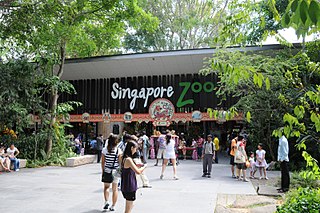
The Singapore Zoo, formerly known as the Singapore Zoological Gardens or Mandai Zoo, is a 28 hectares zoo located on the margins of Upper Seletar Reservoir within Singapore's heavily forested central catchment area. It is operated by the Mandai Wildlife Group, which also manages the neighbouring Night Safari, River Wonders, Bird Paradise as well as the forthcoming Rainforest Wild Park.
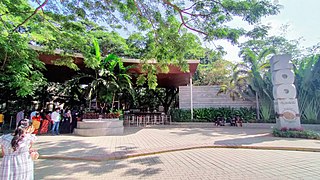
Mysore Zoo, officially known as Sri Chamarajendra Zoological Gardens, is a composite of zoological gardens and animal park located in the southern Indian city of Mysore, Karnataka. Stretching across a 157-acre (64 ha)-expanse and situated at about 700 metres from Mysore Palace, it is the oldest zoo in India and one of the oldest in the world. One of the most popular zoos in India and one of the city's most popular attractions, it is home to a wide range of over 168 species.

Colchester Zoo is a zoological garden situated near Colchester, England. The zoo opened in 1963 and celebrated its 60th anniversary on 2 June 2023. It is home to many rare and endangered species, including big cats, primates and birds as well as many invertebrates and fish species.

The Miami-Dade Zoological Park and Gardens, also known as Zoo Miami, is a zoological park and garden in Miami and is the largest zoo in Florida. Originally established in 1948 at Crandon Park in Key Biscayne, Zoo Miami relocated in 1980 as Miami MetroZoo to the former location of the Naval Air Station Richmond, southwest of Miami in southern unincorporated Miami-Dade County, surrounded by the census-designated places of Three Lakes (north), South Miami Heights (south), Palmetto Estates (east) and Richmond West (west).

Wilhelma is a zoological-botanical garden in Stuttgart in the Bad Cannstatt district in the north of the city on the grounds of a historic castle. Wilhelma Zoo is one of the most popular tourist destinations in Baden-Württemberg, seeing more than 2 million visitors annually.

The Aktiengesellschaft Cologne Zoological Garden is the zoo of Cologne, Germany. Being the third oldest zoo in Germany, it features over 10,000 animals of more than 850 species on more than 20 hectares. The internationally renowned zoo with an attached aquarium and invertebrate exhibit is active in preservational breeding of animals that are in danger of becoming extinct. In addition, in-the-wild conservation efforts and research focussing on animals of Madagascar, Wallacea, and Vietnam are actively promoted and supported via cooperation with Cologne University and local projects, such as in the case of Przewalski's horses.

Ragunan Zoo is a zoo located in Pasar Minggu, South Jakarta, Indonesia. The zoo has an area of 140-hectare (350-acre). The zoo has an aviary and a primate centre, and employs over 450 people. Many of the animals in the zoo are endangered and threatened from all parts of Indonesia and the rest of the world. There are a total of 2,288 animals inside the zoo. Laid out in a lush tropical habitat, rare animals such as crocodile, gorilla, orangutan, tapir, anoa, sumatran tiger, babirusa, and peacocks are given ample room. The zoo is located in South Jakarta and is easily accessible through the Jakarta Outer Ring Road and TransJakarta Corridor 6 bus.

The Indianapolis Zoo is a 64-acre (26 ha) non-profit zoo, public aquarium, and botanical garden in Indianapolis, Indiana, United States. Incorporated in 1944, the Indianapolis Zoological Society established the first zoo at George Washington Park in 1964. The current zoo opened in 1988 at White River State Park near downtown Indianapolis. It is among the largest privately funded zoos in the U.S.
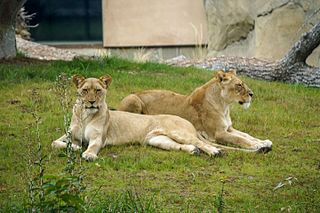
The Fresno Chaffee Zoo is a zoo in Roeding Park in Fresno, California covering 39 acres and housing over 190 species. Its attractions include Stingray Bay, Dino Dig, Valley Farm, Sea Lion Cove, African Adventure, and Ross Laird's Winged Wonders Bird Show. The zoo is accredited by the Association of Zoos and Aquariums (AZA) and is a member of the World Association of Zoos and Aquariums (WAZA).

The National Zoo is a Malaysian zoo located on 110 acres (45 ha) of land in Ulu Klang, Gombak District, Selangor, Malaysia. It was officially opened on November 14, 1963, by the country's first prime minister, Tunku Abdul Rahman. The zoo is managed by a non-governmental organization known as the Malaysian Zoological Society and is home to 5,137 animals of 476 different species. It received MS ISO 9001:2008 certification in July 2007 and is a member of the South East Asian Zoos Association (SEAZA). The president and chairman of the zoo is Y. Bhg. Dato' Ismail Hutson.

The Kansas City Zoo & Aquarium is a 202-acre (82 ha) zoo founded in 1909 and is located in Swope Park at 6800 Zoo Drive, Kansas City, Missouri, in the United States. The zoo has a Friends of the Zoo program to help promote the work of the zoo which sees over one million visitors a year. The zoo is home to nearly 1,700 animals and the aquarium has around 8,000 animals. The zoo is an accredited member of the Association of Zoos and Aquariums (AZA).
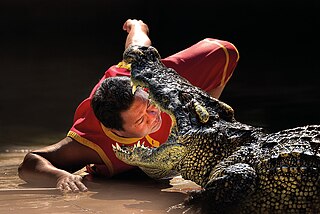
The Samutprakarn Crocodile Farm and Zoo was a famous crocodile zoo in Samut Prakarn Province, Thailand that operated from 1950 to its temporary closure in 2020. During is tenure, the zoo operated as one of the largest crocodile zoos in the world, being home to 60,000 crocodiles. It even claimed to hold the world's largest crocodile in captivity, named Yai, who measured around 6 m and weighed 1,114 kg (2,456 lb). The Covid-19 pandemic and the loss of tourists would later cause the zoo's closure in 2020 before going into liquidation in 2021.
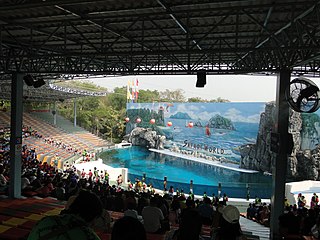
Safari World is a tourist attraction in Bangkok, Thailand that consists of two parks named Marine Park and Safari Park, operated by Safari World Public Limited. The park was opened in 1988 with a total area of 480 acres (190 ha) for its open zoo and 180 acres (73 ha) for its bird park. A major renovation to enhance effectiveness of land use began on 17 April 1989 and its total area developed for the leisure park now consists of an open zoo and a marine park on 500 rai of land.
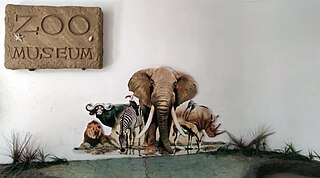
National Zoological Gardens of Sri Lanka is a zoological garden in Dehiwala, Sri Lanka, founded in 1936. It is home to various birds, mammals, reptiles, fish and amphibians. The zoo not only exhibits animals from Sri Lanka, but also exhibits species from across Asian and other parts of the globe.

Barcelona Zoo is a zoo in the Parc de la Ciutadella in Barcelona, Catalonia, Spain. The zoo used to be internationally known as the home of Snowflake, the only known albino gorilla, who died in 2003.

Gembira Loka Zoo is a zoological garden located in Yogyakarta, Special Region of Yogyakarta, Indonesia. Gembira Loka Zoo was opened in 1956 and comprises a botanical garden, orchid nursery, (artificial) lake, children's park, numerous scenic bridges across the Gajahwong River, and a collection of approximately 470 animals, most notable of which are its native Indonesian tigers, leopards, Komodo dragons, saltwater crocodiles, orangutans, and gibbons, as well as African animals such as lions, camels and hippopotamus. The park is 54 acres in size.

Zoo Osnabrück is located in south Osnabrück at the hillside of Schölerberg in Osnabrück, Germany. It was founded under the name "Heimattiergarten", and opened during the summer of 1936. Almost 3000 animals from roughly 300 species can be seen on the 23.5 ha (0.235 km2) land. It is famous for housing the Grolar Bear. This brought about many scientific inquiries into the zoo.






















